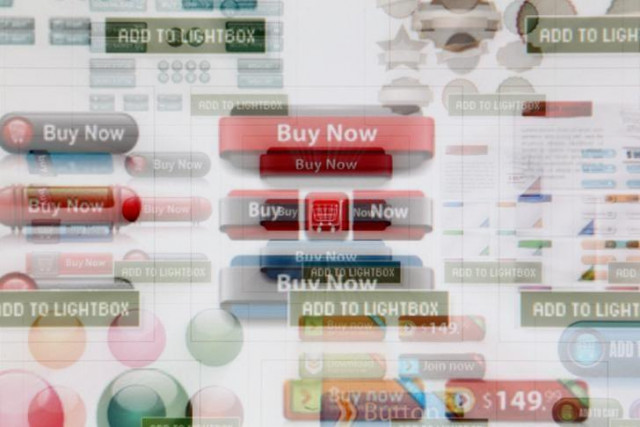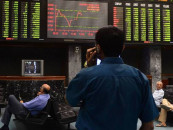E-commerce landscape faces barriers to expansion in Pakistan
Since this industry is in its infancy, taxation should not be a subject of concern

A zoomed image of a computer monitor shows a website selling button clipart for online shops in Vienna November 27, 2013. PHOTO: REUTERS
The country already has 44 million broadband users, which is greater than the population of Canada. Yet the e-commerce industry is valued at a mere $100 million.
In comparison, India’s e-commerce transactions are valued at $12 billion, China’s at $466 billion and the European Union’s at $487 billion.
In 2016, Pakistan was ranked 105th out of 137 countries on the Unctad’s B2C E-Commerce Index, which measures the readiness of countries to engage in online commerce. This is actually a drop in Pakistan’s position compared to the rank of 86 in 2014, hence, the urgent need to address e-commerce issues.
As a technology, e-commerce offers a level playing field to all. Even though Alibaba – Chinese e-commerce giant – does not have an office in Pakistan, its business is doing pretty well all across the country. According to the Economic Survey of Pakistan 2016-17, our wholesale and retail trade as a component of GDP is valued at Rs2,164,404 million ($20.54 billion approximately).
From bricks to bytes: the impressive growth of e-commerce in Pakistan
E-retailer Amazon alone has sales revenues of around $136 billion, six times of what we sell as a country.
E-commerce has many spillover benefits too. Online ride-sharing apps, for example, have not only generated employment opportunities and increased customer choice, but they have also driven up automotive sales in Pakistan.
As per industry data, the demand for Suzuki’s 1,000cc WagonR has surged 172% on a year-on-year basis. Such improving figures are also a boon for the financing industry in the country.
Cash payments dominate
There are only around 400 e-commerce merchants in the country. This translates into a mere 0.44% of more than 900,000 physical retail stores.
Around 80% of the value of e-commerce transactions in Pakistan is paid for by ‘cash on delivery’. Usage of credit/debit cards is far too low as only 36 million (debit and credit) plastic cards have been issued so far.
International payment system providers such as PayPal do not operate in Pakistan. Owing to this, Pakistani online shoppers face difficulties in making purchases and IT services exporters face issues in receiving payments directly into their accounts in Pakistan.
Even Google, which offers localised versions of YouTube, Google, Google News and Google Maps for Pakistan, does not have an office in Pakistan. There is simply a lack of interest due to Pakistan’s strict regulatory regime.
Currently, online marketplace providers cannot ship products directly to customers on behalf of manufacturers because if they do that, they are deemed to be the sellers themselves.
Tax matters
Online marketplaces also face uncertainty in quoting customs duty for their clients as the invoice value is often different from the Federal Board of Revenue’s (FBR) assessed value.
Cyber marketplace providers cannot offer refunds to their foreign clients in case of non-satisfaction with service or product as our current legislation has no provision for such financial transfers.
E-marketplace firms in Pakistan also risk facing double taxation. It is unclear who should be paid the tax if an online marketplace has its address registered in Karachi and enables a customer based in Peshawar to make purchases from a store based in Lahore – either to the Sindh Revenue Board, Khyber-Pakhtunkhwa Revenue Authority or Punjab Revenue Authority? The laws are not defined in this matter.
More importantly, since this industry is still in its infancy, taxation should not be a subject of concern at this stage. The Finance Act 2017 has introduced some relief for the e-commerce sector. The minimum tax on turnover of online marketplaces has been reduced to 0.5% instead of 1.25%. Tax on commissions has been set at 5% instead of 12%.
However, major brands are demanding tax exemptions for three to five years and an increase in the duty-exempt gift items’ value from the current $200 to $250. Their demands are not unjustified given that the e-commerce industry is in its infancy.
Alibaba testing Pakistan’s e-commerce market
Payment repatriation
IT exporters often use the State Bank of Pakistan’s R-Form meant for remittances instead of the E-Form meant for exports, to repatriate their payments to Pakistan. This happens because exporters naturally wish to circumvent payment of duties on exports.
The FBR should eliminate or at least reduce tax on electronic payments so that the practice proliferates further. Tax exemptions, at this point, should not be viewed as a loss of revenue, but rather they should be viewed as a hook.
Once people get accustomed to using plastic cards and e-wallets, all these transactions will become part of the formal economy. Taxation at that point in time will be much more fruitful than it is now.
Unless we build consumers’ trust in electronic payments and make cheaper for the merchants the non-cash payment solutions, e-commerce is not going to see a boost at its full potential.
The government signed a memorandum of understanding in May this year with the Alibaba Group to promote Pakistan’s exports worldwide through e-commerce, which is certainly a positive step.
Companies such as PayPal also need to be lured to begin their operations in Pakistan. Provincial tax authorities should grant exemption from GST on services to e-commerce for at least five years. Once the industry flourishes and gains a strong foothold, only then it should be taxed. The primary aim of the government should not be taxation, but to generate economic activity to sustain growth.
In 1996, 29 WTO members signed the Information Technology Agreement (ITA), which calls for elimination of tariffs on IT products. Today, it has 82 participants who represent 97% of the global trade in IT products.
Pakistan is not yet a participant of ITA. The reason for this is not to miss out on the customs duty collected on IT imports.
When it comes to erecting barriers to free trade and imports, an important principle to remember is that what goes around comes around.
The writer is a research associate at the Policy Research Institute of Market Economy
Published in The Express Tribune, September 18th, 2017.
Like Business on Facebook, follow @TribuneBiz on Twitter to stay informed and join in the conversation.



















COMMENTS
Comments are moderated and generally will be posted if they are on-topic and not abusive.
For more information, please see our Comments FAQ